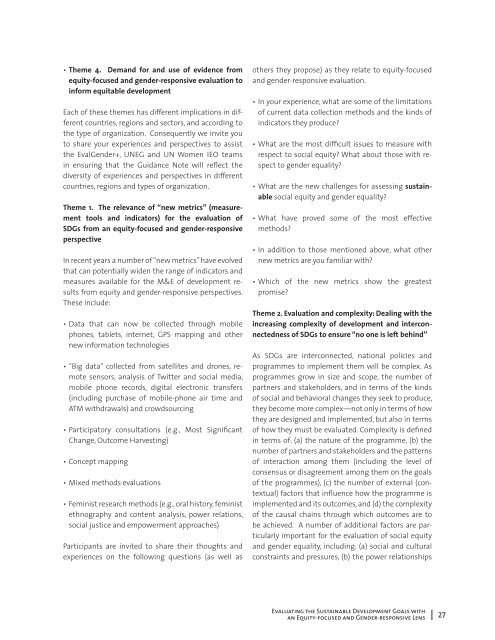NO ONE LEFT BEHIND
NY-Events-Report_WEB
NY-Events-Report_WEB
You also want an ePaper? Increase the reach of your titles
YUMPU automatically turns print PDFs into web optimized ePapers that Google loves.
••<br />
Theme 4. Demand for and use of evidence from<br />
equity-focused and gender-responsive evaluation to<br />
inform equitable development<br />
Each of these themes has different implications in different<br />
countries, regions and sectors, and according to<br />
the type of organization. Consequently we invite you<br />
to share your experiences and perspectives to assist<br />
the EvalGender+, UNEG and UN Women IEO teams<br />
in ensuring that the Guidance Note will reflect the<br />
diversity of experiences and perspectives in different<br />
countries, regions and types of organization.<br />
Theme 1. The relevance of “new metrics” (measurement<br />
tools and indicators) for the evaluation of<br />
SDGs from an equity-focused and gender-responsive<br />
perspective<br />
In recent years a number of “new metrics” have evolved<br />
that can potentially widen the range of indicators and<br />
measures available for the M&E of development results<br />
from equity and gender-responsive perspectives.<br />
These include:<br />
••<br />
Data that can now be collected through mobile<br />
phones, tablets, internet, GPS mapping and other<br />
new information technologies<br />
••“Big data” collected from satellites and drones, remote<br />
sensors, analysis of Twitter and social media,<br />
mobile phone records, digital electronic transfers<br />
(including purchase of mobile-phone air time and<br />
ATM withdrawals) and crowdsourcing<br />
••<br />
Participatory consultations (e.g., Most Significant<br />
Change, Outcome Harvesting)<br />
••<br />
Concept mapping<br />
••<br />
Mixed methods evaluations<br />
••<br />
Feminist research methods (e.g., oral history, feminist<br />
ethnography and content analysis, power relations,<br />
social justice and empowerment approaches)<br />
Participants are invited to share their thoughts and<br />
experiences on the following questions (as well as<br />
others they propose) as they relate to equity-focused<br />
and gender-responsive evaluation.<br />
••<br />
In your experience, what are some of the limitations<br />
of current data collection methods and the kinds of<br />
indicators they produce?<br />
••<br />
What are the most difficult issues to measure with<br />
respect to social equity? What about those with respect<br />
to gender equality?<br />
••<br />
What are the new challenges for assessing sustainable<br />
social equity and gender equality?<br />
••<br />
What have proved some of the most effective<br />
methods?<br />
••<br />
In addition to those mentioned above, what other<br />
new metrics are you familiar with?<br />
••<br />
Which of the new metrics show the greatest<br />
promise?<br />
Theme 2. Evaluation and complexity: Dealing with the<br />
increasing complexity of development and interconnectedness<br />
of SDGs to ensure “no one is left behind”<br />
As SDGs are interconnected, national policies and<br />
programmes to implement them will be complex. As<br />
programmes grow in size and scope, the number of<br />
partners and stakeholders, and in terms of the kinds<br />
of social and behavioral changes they seek to produce,<br />
they become more complex—not only in terms of how<br />
they are designed and implemented, but also in terms<br />
of how they must be evaluated. Complexity is defined<br />
in terms of: (a) the nature of the programme, (b) the<br />
number of partners and stakeholders and the patterns<br />
of interaction among them (including the level of<br />
consensus or disagreement among them on the goals<br />
of the programmes), (c) the number of external (contextual)<br />
factors that influence how the programme is<br />
implemented and its outcomes, and (d) the complexity<br />
of the causal chains through which outcomes are to<br />
be achieved. A number of additional factors are particularly<br />
important for the evaluation of social equity<br />
and gender equality, including: (a) social and cultural<br />
constraints and pressures, (b) the power relationships<br />
Evaluating the Sustainable Development Goals with<br />
an Equity-focused and Gender-responsive Lens 27


